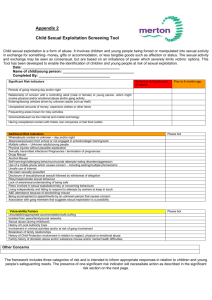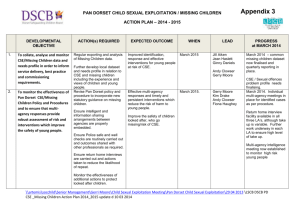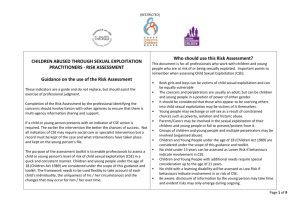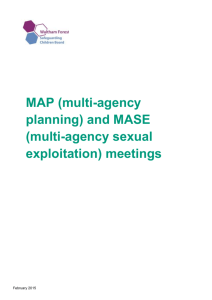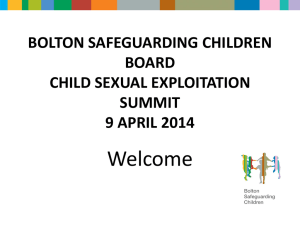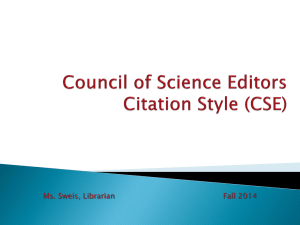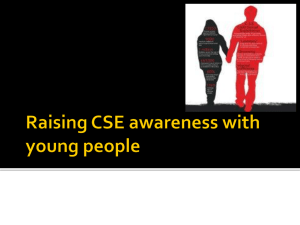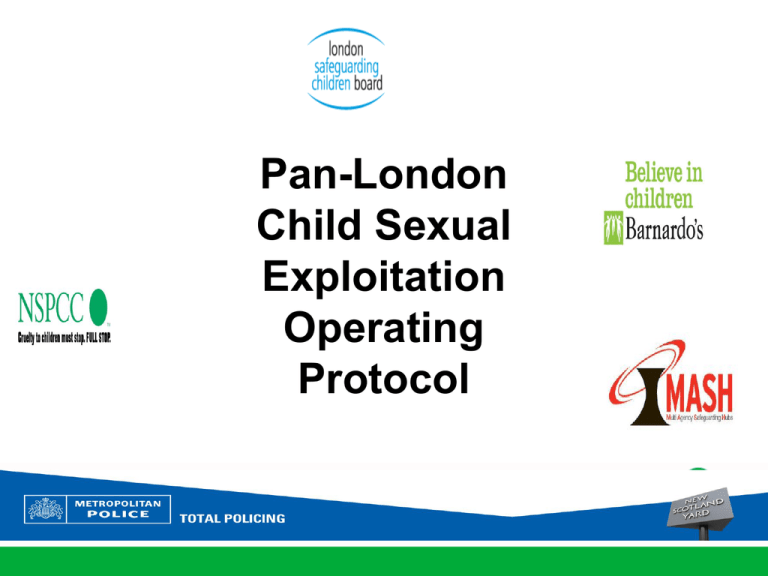
Pan-London
Child Sexual
Exploitation
Operating
Protocol
Nasima Patel
NSPCC
Executive Director of Services For
Children and Families on behalf of
CSE multi-agency working group
Objectives of this presentation
•
•
•
•
•
•
The Pan London protocol
Definitions
Look at action if concerns are identified
What should other agencies be doing?
S.A.F.E.G.U.A.R.D. mnemonic
Be confident in your practice
Pan London CSE protocol
This is the new improved working
arrangement for all c/yp that are identified as
being sexually exploited (CSE) or at risk of
CSE across London.
To be used by all professionals.
Governance
• Metropolitan Police have adopted it - Pilots
in two areas and other areas working to it.
• Consultation with expected sign off by Dec
2013 by Pan London LSCB
• Incorporated into revamped London
LSCB guidance and procedures.
• It will be THE multi-agency framework
Purpose of the Protocol
•
•
•
•
Clarify roles and responsibilities
Ensure common understanding of CSE
Clarify exact referral routes
Advice on meeting and info-sharing
structure.
• Detail role of MASH
Why a new protocol
• Under identification is of real concern.
• Ensure C&YP get the safeguarding
response they need
• Better Working Together arrangements
• To build on current good practice
• To support Met Police new pathways
The Key Principles
•
•
•
•
•
•
Sexually exploited children should be treated as victims
Recognition is critical
Overlaps with other vulnerabilities
Coercion, enticement, manipulation or desperation.
Range of behaviors and offences
Coordination and leadership are key
Key principles
• Distinguishing challenge between own choices
and the sexual activities they are coerced into
• Law enforcement must direct resources
against the coercers and sex abusers
• Sexually exploited children are children in need
of services under the Children Act 1989 and
2004
• They are also in need of immediate protection
• A Multi-agency network or planning
meeting/discussion/process is central
The Definition
Sexual exploitation of children and young
people under 18 involves exploitative
situations, contexts and relationships where
the young person (or third person/s) receive
‘something’ (eg, food, accommodation,
drugs, alcohol, cigarettes, affection, gifts,
money) as a result of them performing,
and/or another or others performing on
them, sexual activities.
The Definition Continued
Child sexual exploitation can occur through the use
of technology without the child’s immediate
recognition; for example being persuaded to post
images on the internet/mobile phones without
immediate payment or gain.
Violence, coercion and intimidation are common.
Involvement in exploitative relationships is
characterised by the child’s or young person’s limited
availability of choice as a result of their social,
economic or emotional vulnerability.
The Definition Continued
A common feature of CSE is that the child or
young person does not recognise the
coercive nature of the relationship and
does not see themselves as a victim of
exploitation
(Association of Chief Police Officers CSE Report – 2013)
CSE can affect many young people, vulnerability is
the most clear identifying factor
Push
•
•
•
•
•
•
•
•
•
•
•
•
•
Neglect
Disruption
Violence
Sexual abuse
Substance misuse (parents)
Mental health (parents)
Gang association
Conflict
Over strict
Forced marriage
Care system
School not working
Loss and bereavement
Pull
• Street life – dissociation
from family and education
• ‘Safety’ of adults
• Gang activity
• Peers already involved
• Economic
• Criminal activity
• Blackmail
SAFEGUARD MNEMOIC
•
•
•
•
•
•
•
•
•
S - exual health and behaviour concerns
A - bsent from school or repeatedly running away
F - amilial abuse and/or problems at home
E - motional and physical condition
G - angs, older age groups and involvement in crime
U - se of technology and sexual bullying
A - lcohol and drug misuse
R - eceipt of unexplained gifts or money
D - istrust of authority figures
There are many models of CSE, more will emerge,
hybrid dynamic nature of these is key to
understanding young people’s experience
Gangs
&
groups
Older
‘boyfriend’
Trafficked
Child Sexual
exploitation
Sexual
Bullying
Online
Opportun
istic
Familial
Shared Risk Assessment
Category 1: At Risk
Indicators suggesting
risk but often no clear
‘evidence’, just concern.
Category 2: Risk is
evident
Evidence of targeting,
concern about coercion,
control. Indicators are
clearer
Shared Risk Assessment
Category 3
A child or young person whose sexual
exploitation is habitual, often self denied and
where coercion/ control is implicit
Referral pathways (non-police)
• Ensure that as much detail as possible is
gathered, including what warning signs are
identified
• The normal Social Care referral pathways
should be followed
• A risk assessment will be made by Social
Care as to which category (London
Procedures)
Referral Pathways (non-police)
• Allocated Social Worker will risk assess
• Allocated Social Worker will let MASH
know
• If no Social Worker, then MASH will pick,
gather information from all agencies, risk
assess and progress.
• Feedback should be given and all
decisions should be multi-agency
Referral pathways – Police
•
•
•
•
Officer conducts risk assessment
R.A.R.A ( Remove, avoid, reduce and accept)
High risk will go to sexual exploitation police team
If YP is low risk, will make CRIS report and forward
to MASH for follow up
• All CSE YP will have a CRIS report with CSE flag
and a Merlin report
• Combined with a focus on disruption, intelligence
and contact with key agencies and partners
Multi-Agency Panels (MAP),
Convened by the Lead Agency, often Children’s
Services, as specified by the London Child Protection
Procedures. This is for casework planning
Cross borough meetings for those children that are
placed out of borough should also be established where
required
The CSE lead in Children’s Services feeds trends into the
Multi Agency Sexual Exploitation meeting. (MASE)
Multi-Agency Sexual Exploitation
Meeting (MASE)
• Each borough should establish a MASE meeting
• The MASE Meeting will co-ordinate the tactical
responses
• This is the meting that links the
individual/operational to the strategic for
intelligence and planning.
Multi-Agency Sexual Exploitation
Meeting (MASE)
• Named SPOC’s from each agency are
expected to attend these meetings
• Any intelligence should be fed through into
the Police and LSCB by respective SPOCs
• Meeting will maintain detailed overview of
CSE case, trends, prevalence and patterns.
• Linked to LSCB and Sexual exploitation
Command
Local Safeguarding Children’s Boards
Meeting (LSCB) Lead Agency Children’s Services.
• The CSE lead (SPOC) for each agency will report to
the Children’s Services member on the LSCB
• The LSCB should directly, or through a sub-group,
establish a local strategy which includes a
prevention strategy, measures for identifying
outcomes for CSE and an agreed approach to
obtain a data set of CSE cases across Children’s
Services and other agencies.
Early findings
Lewisham and Camden
Lewisham and Camden
• Training of oos of officers
in CSE
• More involvement of
police in multi-agency
work.
• MASE meetings working.
• Improved coordination
• Enhanced understanding
of peer issues
• More young people
identified and receive a
service.
• Still girls, not boys.
• First abduction notice.
• Different decisions about
children
• Way to go
The beginning of real work
The significant shift that is currently being made
in CSE work is the shift from being a primarily a
victim needs led response to a much more child
protection response which includes support for
victims, a priority to secure prosecutions using joint
investigation approaches within a wider
community safety agenda
Multi-agency approaches and leadership at all
levels from all agencies.
Thank You
Nasima Patel
NSPCC
Executive Director of Services For Children and
Families on behalf of CSE multi-agency
working group



